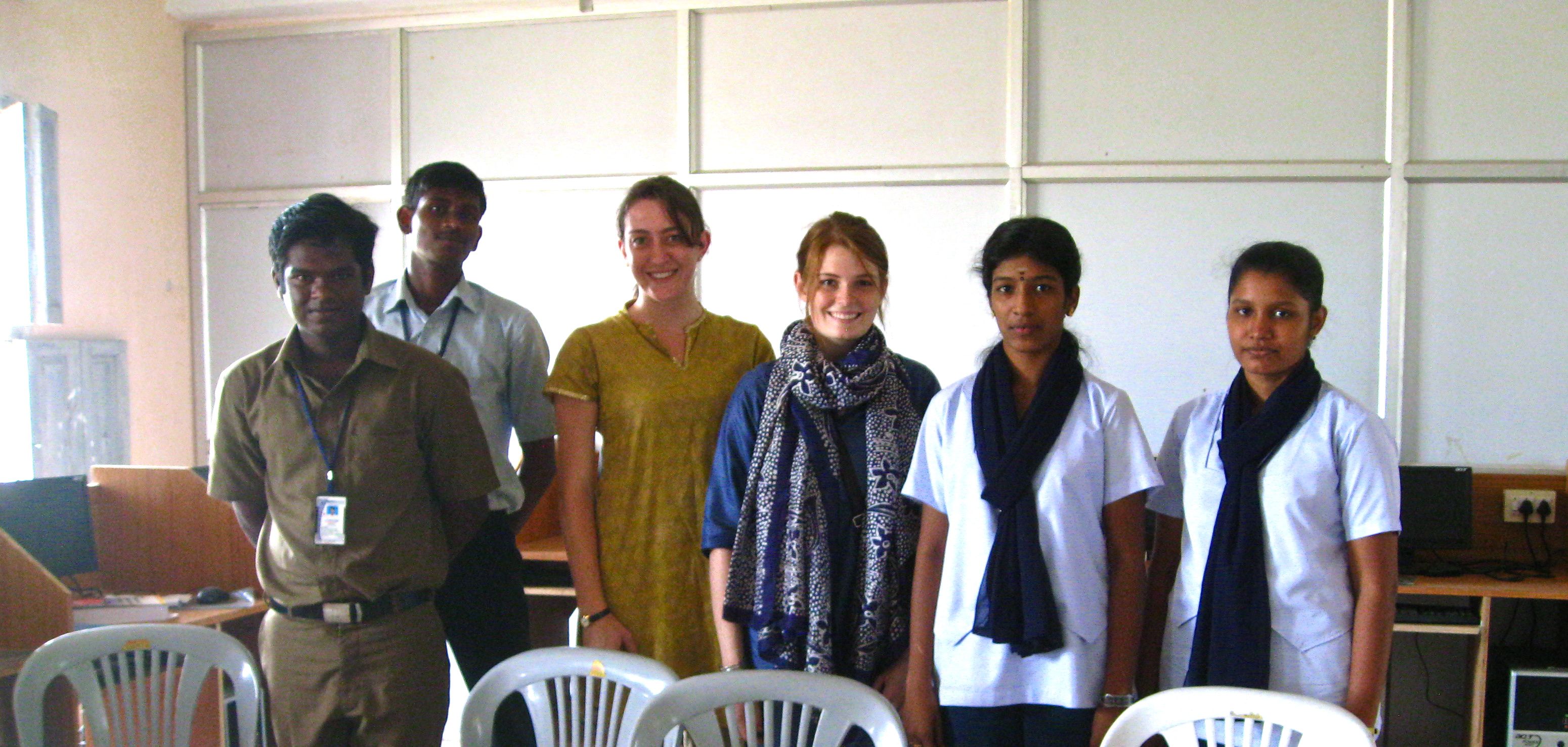At the beginning of the summer, the six of us Stanford summer interns set out to determine, through field interviews and market research, if there was a viable gap in the higher education loan market in Thanjavur that KGFS might productively fill by offering its own education loan product, thereby allowing more low-income students to pursue higher education. With the help of colleagues from IFMR Ventures and Tamil-speaking researchers from the InnerWorlds team, we began a unique research project that would take us into rural villagers’ homes, bustling bank branches and college campuses across Thanjavur district. Now that our last day in Chennai has arrived, we take this opportunity to summarize our experience and some of our discoveries.
On our first research trip to Thanjavur district, we conducted interviews with secondary school administrators, college principals, students, and bank managers within the city of Thanjavur and nearby areas. As a result of these interviews, we found ourselves somewhat discouraged as to the need of a KGFS higher education product. This discouragement stemmed, above all, from our discovery that commercial banks were mandated by the Tamil Nadu government to extend higher education loans to all deserving students, without collateral, for amounts up to 4 lakh rupees. Moreover, the mandate had recently been expanded such that students did not have to pay interest on the loans while enrolled in college. Given this mandate, as well as the existence of many government scholarship programs, it seemed to us that the introduction of a KGFS product might be unnecessary. After all, students–including low-income ones who did not have collateral–could simply avail a relatively low-cost education loan at a commercial bank if they needed one, and would not even have to pay interest on it for a few years.
However, upon returning to Thanjavur for a second round of research interviews, this time focusing more on the small villages in the surrounding area, we began to uncover gaps in the loan disbursal process that increasingly indicated the value of developing a new loan product. To begin with, we found that even though banks were required by law to extend these education loans, they tended to “hesitate” on doing so. They frequently delayed approving loans to low-income individuals for as long as possible, through such methods as continually requesting more paperwork from applicants.
In our interviews with students we found that these delays frequently lasted several months, often forcing their families to resort to higher cost financing options. In our discussions with bank managers, they were very frank with us about the reason for the banks’ attitude: repayment rates for educational loans are very low in Thanjavur district and across India, often coming in at between 50% and 60%. Though banks are compelled to offer these education loans because of the government mandate, they are simply not good business for the banks. Another consideration that we encountered is that there are significant costs associated with pursuing a higher education on top of tuition, which is the only cost that many bank loans and government scholarships cover. These additional costs include, but are not limited to, housing, college “donation” fees, transportation, school supplies, and the opportunity cost of foregoing entry into the labor force.

We returned to IFMR headquarters in Chennai and, after a lot of research and many brainstorming sessions, we designed a menu of loan products that we believe address many of the constraints to financing higher education that we encountered through our field research in Thanjavur. These products include a bridge loan, to be disbursed to families waiting for an education loan from the bank to be disbursed; a supplemental loan, to cover a student’s costs other than tuition; and a savings program. We also explored various ways to increase repayment rates and ensure the financial sustainability of these products.
We believe that KGFS’s unique position within the social structure of villages gives it a marked advantage over commercial banks when it comes to encouraging repayment. Finally, we put forth a proposal for the establishment of an independent education office within villages, which would be charged with the duty of raising awareness about the requirements, financial and otherwise, of higher education planning. We believe such an education office would contribute enormously toward the goal of increasing the number of low-income villagers who decide to pursue a higher education, and address the principal challenge that we identified in our field research: an information gap regarding financial and educational opportunities. We hope that at least some of the suggestions in our final report will prove useful for KGFS and can be developed into financial instruments to be offered to students in Thanjavur, allowing more of them to pursue a higher education and ultimately secure employment.
As we return to Stanford to complete our own higher educations, we will bring with us fond memories from our field research–including playing cricket and eating fantastic home-cooked meals in villagers’ homes, and working with a truly inspiring and diverse team of IFMR colleagues. We are all grateful to have gained a greater understanding of rural India and of the role of finance in reducing poverty. We look forward to following the progress of KGFS’s higher education products and other IFMR projects in the future.



10 Responses
It is really sad that bankers accept in public about their disinterest for giving loans to the lower strata. Said that I really appreciate IFMR and the Stanford team took effort to bridge the gap. Kudos to you guys!
There is no doubt a reluctance on the part of commercial banks to disburse loans to the poor. I do agree with the idea of a supplemental loan, to cover student’s costs other than tuition and a savings program. However a bridge loan could turn out to be a regular education loan of KGFS, as education loan from the bank to be disbursed may not get disbursed at all – two reasons 1. banks have innumerable reasons to reject a loan 2. once a bridge loan is given by KGFS the student may not vigorously pursue his/her bank loan due to a) having received the funding b) the hassle of repeated visits as well submission of multiple documents to get the loans disbursed by banks. Your idea of independent education office, I must say will be very useful.
I think this is a wonderful piece of work done by the talented Stanford Team – a great benchmark for the manner in which product development should be done — out in the field, interacting with customers and building an in-depth understanding before rolling out a product idea.
I personally think it is a mistake to think of banking as a free public good — it is a business and has its own discipline. What the research is pointing out is that even though the banks are owned by the government they are being responsible and are not prepared to lend money in the face of 50 to 60% default — for all of us as citizens of India this should be good news and as a former banker I certainly have sympathy for this attitude of banks. What this reluctance also points out is that without a proper understanding and control of the two key issues: adverse selection and moral hazard it is not possible to build a high quality financial product. It is the view of the Trust that for this understanding and control to happen there is a need for a local financial institution operating on the ground with wealth managers who have an intimate understanding of the customer — there are no short cuts around this particularly for loans.
I think Mr. Chandrachudan is making a very good point and I entirely agree with his analysis that the bridge loan is a bad design though not with the underlying message of "warning" that I detect — I would replace that with a sense of excitement about the opportunity of having identified a significant gap in the economy which the KGFS' will easily be able to fill. I believe that the core principles of local origination and transmission need to be respected before the asset is handed over to an aggregator like a large, well capitalised commercial bank — the originator must hold substantial first loss, the "transmitter" must hold a reasonable amount of second loss and only then must the aggregator part with senior loan resources. To my mind building a full securitisation strategy, given its importance, perhaps just for education loans may be an interesting idea to explore with IFMR Capital.
Yeah. I agree that we need to look at this as a great opportunity. Local originators have been proving that default rate can come down considerably – in fact near zero default – as the process of their engagement with local masses is very different as compared to commercial banks. It will be a great win-win opportunity for both banks as well as the local lender (KGFS), if your suggestion is taken forward.
Firstly, I would like to thank the Stanford team for conducting this study at the grassroots level. Trust this initiative by them encourages Indian suits to follow suit on other socially relevant subjects.
With respect to the article, I cannot help but raise the level of this discussion. I think it was the NKC that had recommended the rejuvenation of an Educational Finance Institution in India. Such a finance institution could do well to refinance the educational loans of commercial banks, thereby lending them capital plus confidence to further the education loan business. It would be great if respected and knowledgeable personalities like Mr Mor push for structural changes at the national level which could then translate to the end-users' benefit
Wow! What a classic example of customer driven product development …. makes a nice case study!
I do agree with @chandrachudan that the bridge loan can become a complete edu loan, however if KGFC can securitize / refinance / insure the loan with regular commercial banks, it can not only derisk its own business model, it can also help the commercial bank involved to improve its "compliance" with the govt regulation creating a win-win for both!
Have there been any structures where the first loss guarantee is provided by the loan-taking client, the second loss by the originator and an additional layer of security (maybe a 'third loss') by the risk-transmititng organisation? Where students are investing in their future, it might make sense for them to have a stake as well. In fact, some students of a Chennai-based financial research institution wanted to securitise the education loans they had taken- could this be the structure for them?
Very interesting post. I really agree with this, we need to look at this as a great opportunity.Firstly, I would like to thank the Stanford team for conducting this study at the grassroots level.If you need more banking sites for offering the Education loan then to visit this page:http://www.apsira.com/loans/index.php#allBanksBox
Very interesting post. I really agree with this, we need to look at this as a great opportunity.Firstly, I would like to thank the Stanford team for conducting this study at the grassroots level.If you need more banking sites for offering the Education loan then to visit this page:http://www.apsira.com/loans/index.php#allBanksBox
This is a great oppurtunity we need to look at to reap the benefits. I hope the bridge loan would definetely become a complete educational loan. Definetelt this would stand as a benchmark amongst product development sector.